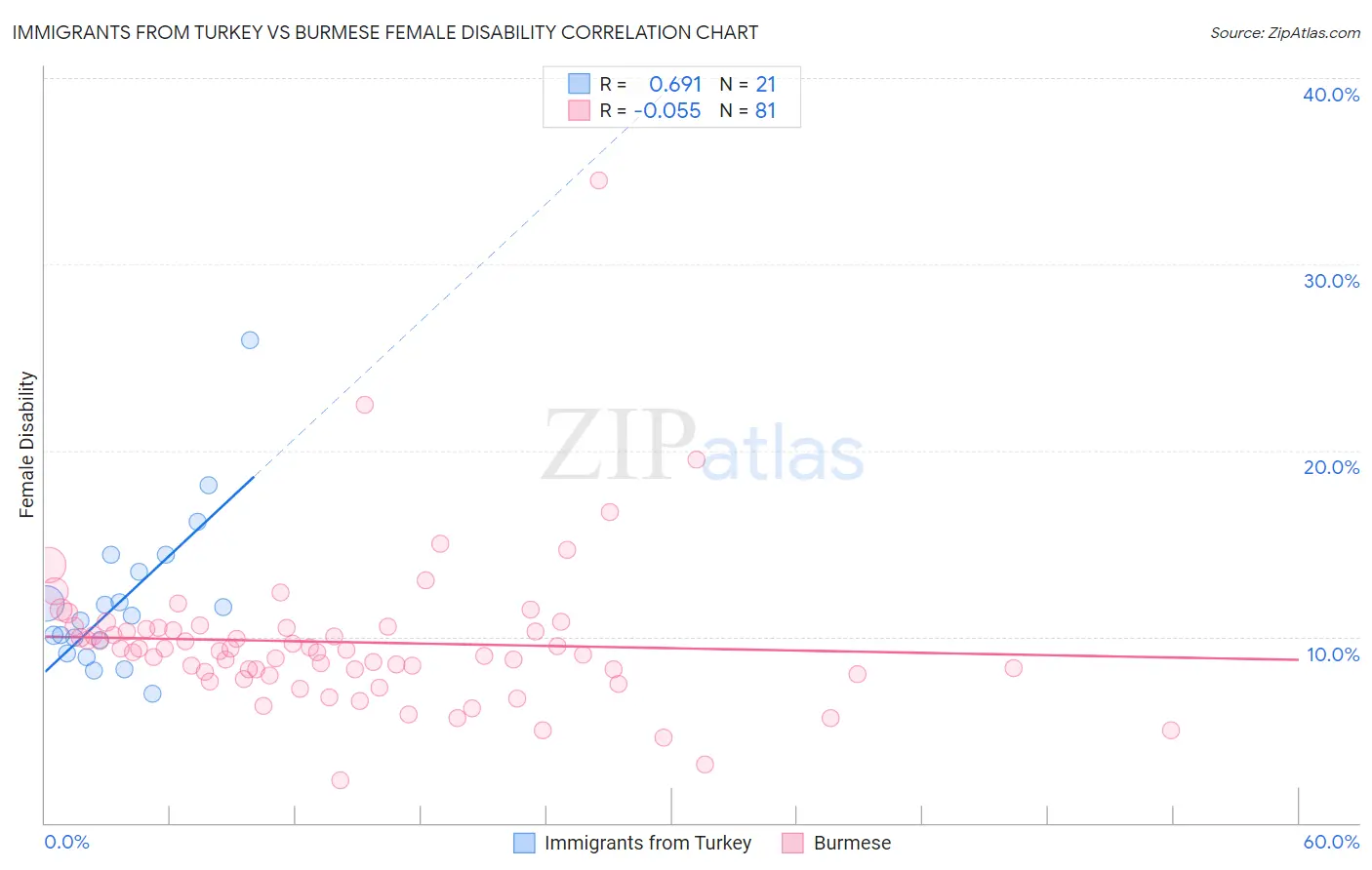Immigrants from Turkey vs Burmese Female Disability
COMPARE
Immigrants from Turkey
Burmese
Female Disability
Female Disability Comparison
Immigrants from Turkey
Burmese
11.1%
FEMALE DISABILITY
100.0/ 100
METRIC RATING
27th/ 347
METRIC RANK
10.7%
FEMALE DISABILITY
100.0/ 100
METRIC RATING
15th/ 347
METRIC RANK
Immigrants from Turkey vs Burmese Female Disability Correlation Chart
The statistical analysis conducted on geographies consisting of 223,044,137 people shows a significant positive correlation between the proportion of Immigrants from Turkey and percentage of females with a disability in the United States with a correlation coefficient (R) of 0.691 and weighted average of 11.1%. Similarly, the statistical analysis conducted on geographies consisting of 465,299,673 people shows a slight negative correlation between the proportion of Burmese and percentage of females with a disability in the United States with a correlation coefficient (R) of -0.055 and weighted average of 10.7%, a difference of 2.9%.

Female Disability Correlation Summary
| Measurement | Immigrants from Turkey | Burmese |
| Minimum | 6.9% | 2.3% |
| Maximum | 25.9% | 34.5% |
| Range | 19.0% | 32.2% |
| Mean | 12.0% | 9.7% |
| Median | 11.2% | 9.3% |
| Interquartile 25% (IQ1) | 9.5% | 8.1% |
| Interquartile 75% (IQ3) | 13.9% | 10.5% |
| Interquartile Range (IQR) | 4.5% | 2.4% |
| Standard Deviation (Sample) | 4.2% | 4.1% |
| Standard Deviation (Population) | 4.1% | 4.1% |
Demographics Similar to Immigrants from Turkey and Burmese by Female Disability
In terms of female disability, the demographic groups most similar to Immigrants from Turkey are Egyptian (11.1%, a difference of 0.27%), Immigrants from Malaysia (11.1%, a difference of 0.34%), Turkish (11.1%, a difference of 0.34%), Argentinean (11.0%, a difference of 0.40%), and Immigrants from Asia (11.0%, a difference of 0.44%). Similarly, the demographic groups most similar to Burmese are Okinawan (10.8%, a difference of 0.070%), Indian (Asian) (10.8%, a difference of 0.39%), Immigrants from China (10.7%, a difference of 0.51%), Immigrants from Eastern Asia (10.7%, a difference of 0.54%), and Immigrants from Israel (10.7%, a difference of 0.62%).
| Demographics | Rating | Rank | Female Disability |
| Immigrants | Korea | 100.0 /100 | #11 | Exceptional 10.6% |
| Immigrants | Israel | 100.0 /100 | #12 | Exceptional 10.7% |
| Immigrants | Eastern Asia | 100.0 /100 | #13 | Exceptional 10.7% |
| Immigrants | China | 100.0 /100 | #14 | Exceptional 10.7% |
| Burmese | 100.0 /100 | #15 | Exceptional 10.7% |
| Okinawans | 100.0 /100 | #16 | Exceptional 10.8% |
| Indians (Asian) | 100.0 /100 | #17 | Exceptional 10.8% |
| Immigrants | Iran | 100.0 /100 | #18 | Exceptional 10.8% |
| Immigrants | Venezuela | 100.0 /100 | #19 | Exceptional 10.9% |
| Immigrants | Pakistan | 100.0 /100 | #20 | Exceptional 10.9% |
| Asians | 100.0 /100 | #21 | Exceptional 10.9% |
| Immigrants | Sri Lanka | 100.0 /100 | #22 | Exceptional 10.9% |
| Venezuelans | 100.0 /100 | #23 | Exceptional 11.0% |
| Immigrants | Argentina | 100.0 /100 | #24 | Exceptional 11.0% |
| Immigrants | Asia | 100.0 /100 | #25 | Exceptional 11.0% |
| Argentineans | 100.0 /100 | #26 | Exceptional 11.0% |
| Immigrants | Turkey | 100.0 /100 | #27 | Exceptional 11.1% |
| Egyptians | 100.0 /100 | #28 | Exceptional 11.1% |
| Immigrants | Malaysia | 100.0 /100 | #29 | Exceptional 11.1% |
| Turks | 100.0 /100 | #30 | Exceptional 11.1% |
| Immigrants | Kuwait | 100.0 /100 | #31 | Exceptional 11.1% |